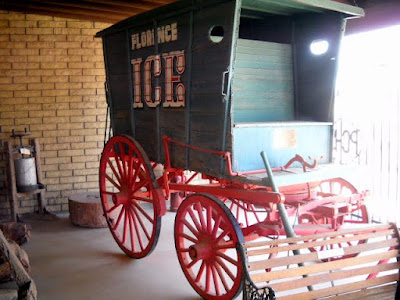
As a very young child, I remember the ice man delivering ice for our ice box. Of course, he didn't come in a horse-drawn wagon. As soon as an electric refrigerator was available after the end of World War II, my parents bought one. I imagine the ice man was out of business in Denver by about 1946.
Chris Reid runs the museum and also is senior warden at St. Michael's Episcopal Church in Coolidge, where we worship and John assists on Sunday. She gave us an excellent tour of the museum collection. We have never before seen furniture made out of saguaro cactus ribs. Isn't this set beautiful? The builder found some really large saguaros.

For a number of years, Florence had a company that manufactured furniture from cholla cactus. The texture of that wood is really attractive.

Southern Arizona was the home of several bands of Apache Indians--some still live here. This is a display of Apache Playing Cards, patterned after the cards we know today. Apparently the Apache really enjoyed gambling on card games.

The museum has a very good display of artifacts and information on the Hohokam sites in the County, including Casa Grande Ruins where we are volunteers. This yucca sandal is very interesting.

Two well-known mid-20th century icons, Tom Mix and a comic strip named "Gordo", have ties to Florence. Mix's daughter moved to the town with her husband. Over the years, Mix visited his family here and made lots of friends. Even after his daughter divorced and moved away, he continued to visit friends here. In 1940 he died in an automobile accident nearby on his way to town.

I vaguely remember reading Gordo in the Denver Post. It was written and drawn by Gustavo "Gus" Arriola, who was born in Florence and he loosely based part of the comic strip on the local area.

Florence is home to two Arizona state prisons, as well as a Border Patrol detention facility and two private prisons. In 1908 the Arizona Territorial Prison moved from Yuma to Florence, in part because the Phoenix-Tucson area accounted for the largest number of inmates. The Pinal County Museum houses many prison artifacts and files, including this trap door used when a death sentence was by hanging. We are looking at the bottom of the trap door.

For years, a new noose was used for each prisoner hung and afterwards, a photo of the prisoner was framed inside the noose and hung on death row. Here are three of those.

Winnie Ruth Judd, the "Notorious Trunk Murderess", was housed at the Florence prison. There is a quite a display of artifacts associated with her, including two books written about her.

After leaving the museum, we visited the Florence hardware store. It is a great place, but that will have to wait for another post.

Did you stop at the prison gift shop? That's where I want to go. I really like the saguaro furniture.
ReplyDeleteWe had an iceman who filled out icebox up into the 50's. It seems we were always the last family to get the latest appliance. The cottage we went to in the summer had an ice house which local men filled for us in the Winter with ice cut on the lake.
ReplyDeleteThe ice business was very important and a large industry. Farmers cut ice from their ponds to supply ice to cool milk. Fishermen needed ice to store fish. The electric fridge ended all this. I cut ice for an ice house they have at our local museum. I wonder how they cut and stored ice in the South?
I love the furniture it is elegant as well as rustic.
I love First Nation's artifacts. Often their technology was perfectly suited for their environment With simple tools they created art as well as utilitarian items.